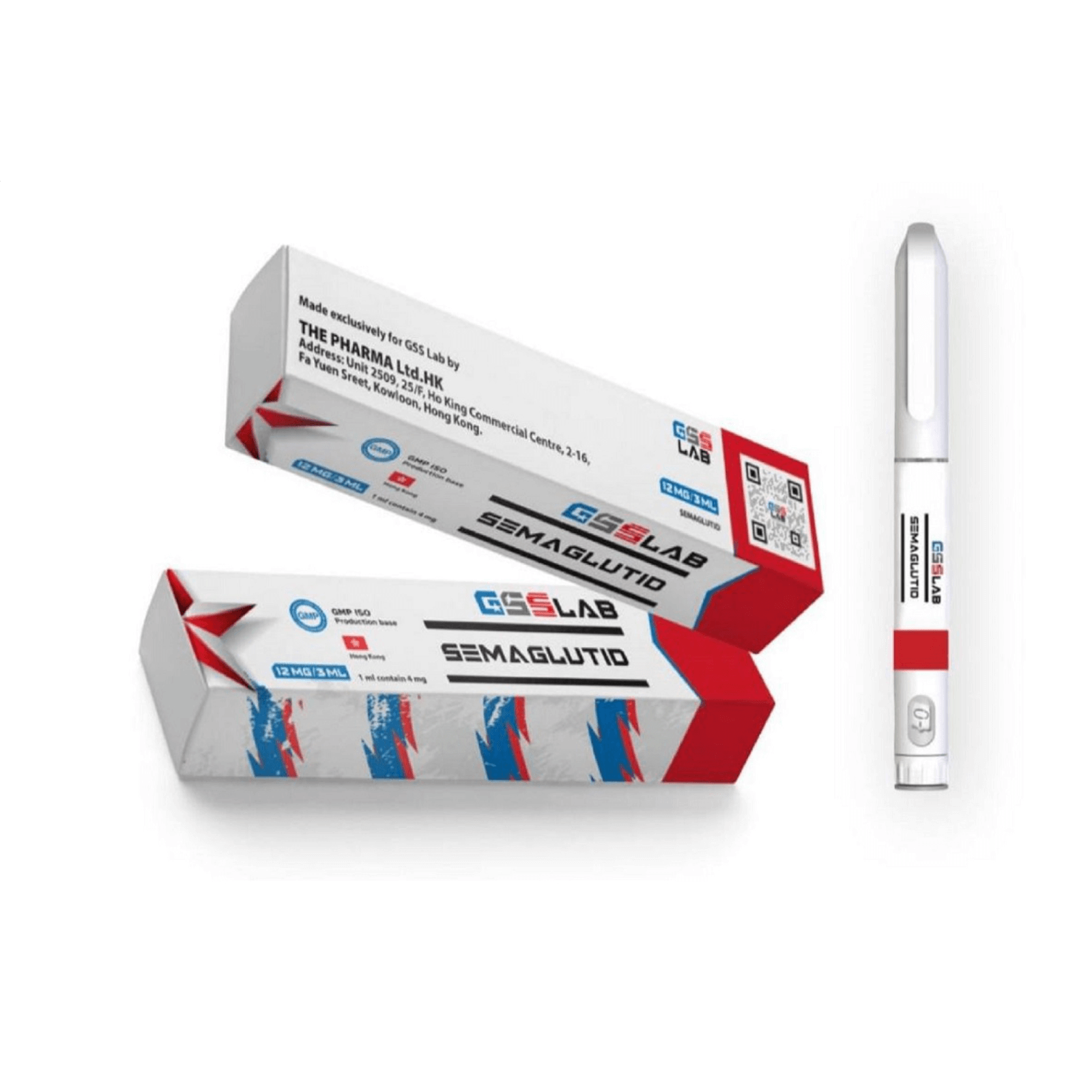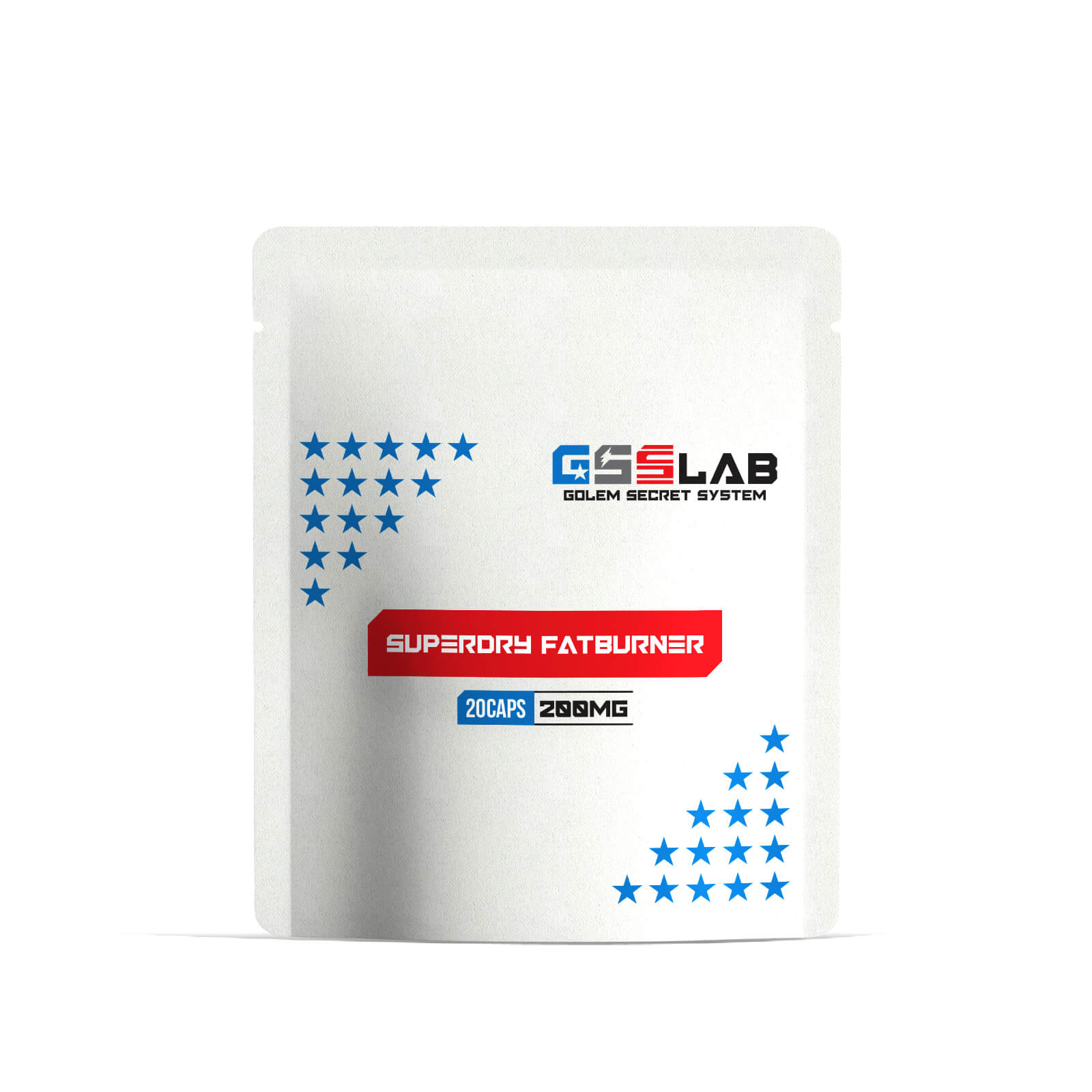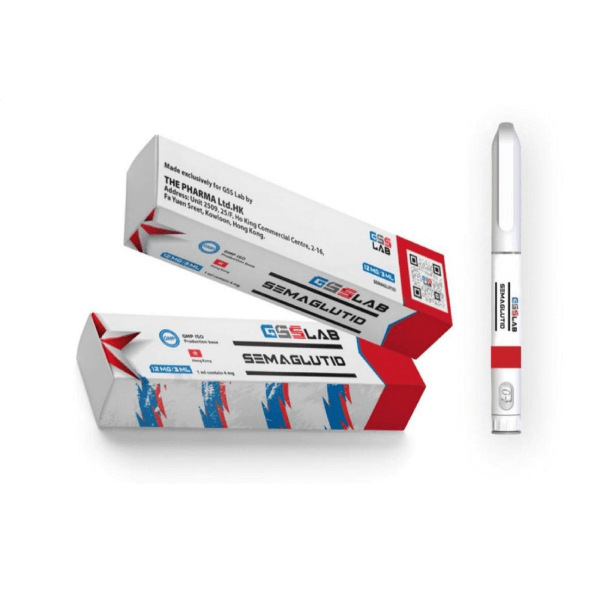Semaglutid
$250.00
Availability: In StockBenefits
Side Effects
Semaglutide
Packaging options:
- 3 ml/12 mg
Concentration:
- 1 ml contains 4 mg of the active substance.
Dosage regimen:
Administer subcutaneously in the abdomen, thigh, or shoulder. Administer once a week at any time, irrespective of food intake. If needed, the day of the weekly administration can be adjusted, ensuring that there is a minimum interval of 3 days (over 72 hours) between injections.
The initial dose is 0.28 mg once a week (7 clicks of the pen wheel). After one week of use, if there is insufficient satiety, the dose can be increased to 0.36 mg once a week (9 clicks of the pen wheel). If necessary, the dosage can be escalated to the maximum allowable 1 mg once a week (25 clicks of the pen wheel).
Important: To ensure full delivery of the substance, hold the needle in place for 5-6 seconds post-injection.
Semaglutide acts as a GIP-1 receptor agonist (GIP-1R), produced via recombinant DNA technology using a Saccharomyces cerevisiae strain and subsequently purified. As a GLP-1 analogue, it shares 94% homology with human GLP-1. Semaglutide selectively binds to and activates GIP-1R, which is the target of native GIP-1.
GIP-1 functions as a physiological hormone, influencing multiple aspects of glucose regulation, appetite, and cardiovascular health. Its effects on glucose levels and appetite are mediated by GIP-1R, found in both the pancreas and the brain. Pharmacological levels of semaglutide lower blood glucose levels and body weight through the mechanisms below. GLP-1R is also located in specific cardiac areas, blood vessels, the immune system, and kidneys, and its activation can foster cardiovascular and microcirculatory enhancements. Unlike native GLP-1, semaglutide’s extended half-life (approximately one week) supports subcutaneous administration just once a week.
The main mechanism for semaglutide's sustained action is albumin binding, which reduces renal excretion and shields it from metabolic breakdown. Furthermore, semaglutide maintains stability against degradation by dipeptidyl peptidase-4. This compound lowers blood glucose levels by stimulating insulin secretion and suppressing glucagon secretion in a glucose-dependent manner. Consequently, an increase in blood glucose concentration leads to insulin promotion and glucagon suppression. The glycemic control mechanism includes a slight delay in gastric emptying during the early postprandial phase. During hypoglycemia, semaglutide reduces insulin release without affecting glucagon levels.
In addition, semaglutide decreases total body weight and fat mass by lowering energy expenditure. This process involves an overall reduction in appetite, increasing satiety signals while diminishing hunger signals, alongside improved food intake regulation and decreased food cravings. Insulin resistance may also decrease, potentially due to weight loss. Moreover, semaglutide lowers the inclination towards high-fat food choices.
Animal studies demonstrate that semaglutide is absorbed in distinct brain areas, enhancing satiety signals while reducing hunger signals. By acting on isolated brain tissues, it stimulates neurons associated with the sensation of fullness while inhibiting those tied to hunger. Clinical studies have reported favorable effects of semaglutide on plasma lipid levels, reductions in systolic blood pressure, and curbing inflammation.
In animal studies, semaglutide has shown the capacity to inhibit atherosclerosis development, preventing the progression of aortic plaques and diminishing their inflammation.
Pharmacokinetics:
The half-life of semaglutide is approximately one week. Peak plasma concentration (Tmax) occurs between 1 to 3 days following drug administration. The area under the curve (AUC) achieves stability after 4-5 weeks of once-weekly administration.
Following subcutaneous administration of 0.5 mg and 1 mg semaglutide, mean steady-state plasma concentrations in patients with type 2 diabetes were approximately 16 nmol/L and 30 nmol/L, respectively. Exposure increased proportionally with dose for the 0.5 mg and 1 mg semaglutide doses. Similar exposure was achieved following subcutaneous administration into the anterior abdominal wall, thigh, or upper arm. The absolute bioavailability of semaglutide following subcutaneous administration was 89%. The mean tissue volume of distribution of semaglutide in patients with type 2 diabetes was approximately 12.5 L. Semaglutide was extensively bound to plasma albumin (> 99%). The metabolism of semaglutide occurs via proteolytic cleavage of the peptide backbone and subsequent beta-oxidation of the side chain fatty acid. The gastrointestinal tract and kidneys serve as the primary excretion routes for semaglutide and its metabolites, with approximately two-thirds of the administered dose excreted by the kidneys and one-third through the intestine. Approximately 3% of the administered dose is excreted unchanged by the kidneys. In patients with type 2 diabetes, the clearance of semaglutide was approximately 0.05 L/h. With an elimination half-life of about 1 week, semaglutide remains in circulation for approximately 5 weeks following the last dose.
Indications for the active substance SEMAGLUTIDE:
Use in type 2 diabetes mellitus alongside diet and exercise to improve glycemic control, including: monotherapy; combination therapy with other oral hypoglycemic drugs (OHGD) such as metformin, a sulfonylurea derivative, or thiazolidinedione in patients inadequately controlled with previous therapies; combination therapy with insulin in patients inadequately controlled on insulin and metformin.
Side effects:
Immune system: rare - anaphylactic reactions.
Metabolism and nutrition: very common - hypoglycemia when used with insulin or a sulfonylurea derivative; common - hypoglycemia with other OHGD, decreased appetite.
Nervous system: common - dizziness; infrequent - dysgeusia.
Vision: common - complications of diabetic retinopathy.
Cardiovascular: increased heart rate.
Gastrointestinal: very common - nausea, diarrhea; common - vomiting, abdominal pain, bloating, constipation, dyspepsia, gastritis, gastroesophageal reflux disease, belching, flatulence.
Liver and biliary tract: common - cholelithiasis.
Local reactions: injection site reactions.
Systemic: fatigue.
Laboratory data: common - increased lipase activity, increased amylase activity, decreased body weight.
Contraindications for use:
History of medullary thyroid cancer, including familial; multiple endocrine neoplasia type 2; type 1 diabetes; diabetic ketoacidosis; pregnancy and breastfeeding; age under 18 years; severe liver failure; end-stage renal failure (CC < 15 ml/min); chronic heart failure NYHA classification IV.
With caution:
In patients with renal failure and a history of pancreatitis.
Use during pregnancy and breastfeeding:
Contraindicated during pregnancy and breastfeeding.
Use in liver dysfunction:
Contraindicated in cases of liver dysfunction.
Use in renal dysfunction:
Contraindicated in cases of renal dysfunction.
Use in children:
Contraindicated in children under 18 years.
Special instructions:
Contraindicated in patients with type 1 diabetes or for the treatment of diabetic ketoacidosis. This drug does not replace insulin. The use of GLP-1R agonists may be associated with gastrointestinal adverse reactions.
This should be taken into account when treating patients with renal insufficiency, as nausea, vomiting, and diarrhea can lead to dehydration and worsening kidney function. Cases of acute pancreatitis have been observed with the use of GLP-1 receptor agonists. Patients should be informed about the characteristic symptoms of acute pancreatitis. Caution is advised in patients with a history of pancreatitis.
Patients receiving the medication in combination with a sulfonylurea derivative or insulin may have an increased risk of hypoglycemia. Caution should be exercised when administering semaglutide to patients with diabetic retinopathy who are receiving insulin therapy. Such patients should be under continuous monitoring and receive treatment in accordance with clinical guidelines.
In the post-registration period of the use of another GLP-1 analog, liraglutide, cases of medullary thyroid carcinoma (MTC) have been reported. The available data are insufficient to establish or exclude a causal relationship between the occurrence of MTC and the use of GLP-1 analogs. Patients should be informed about the risk of MTC and the symptoms of thyroid tumors (such as the appearance of a lump in the neck, dysphagia, dyspnea, and persistent hoarseness). A significant increase in calcitonin concentration in plasma may indicate MTC (in patients with MTC, calcitonin levels in plasma are usually >50 ng/L). If an increase in calcitonin concentration in plasma is detected, further examination of the patient should be conducted. Patients with nodules in the thyroid gland, identified during medical examination or through ultrasound of the thyroid, should also undergo further investigation. The use of semaglutide in patients with a personal or family history of MTC or with MEN type 2 syndrome is contraindicated.
Impact on the ability to drive vehicles and operate machinery
Semaglutide does not affect or only slightly affects the ability to drive vehicles or operate machinery. Patients should be warned that they should take precautions to avoid developing hypoglycemia while driving or operating machinery, especially in combination with a sulfonylurea derivative or insulin.
Drug Interaction
The delayed gastric emptying associated with the use of semaglutide may affect the absorption of concomitant oral medications. Semaglutide should be used with caution in patients receiving oral medications that require rapid gastrointestinal absorption. Substances added to the medication may cause degradation of semaglutide. It should not be mixed with other medications, including infusion solutions.





